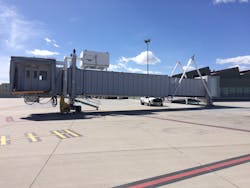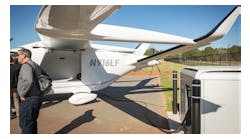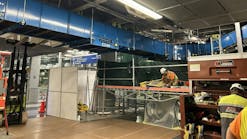When Sarasota Bradenton International Airport (SRQ) opened its new terminal in 1989, they found themselves with new boarding bridges at 13 gates, all owned by the airport with standardized equipment.
But after 28 years of use and abuse from the Florida climate, airport leaders decided it was time to upgrade the bridges and add a very crucial piece of equipment when it comes to life in the south — air conditioning. And with equipment pushing three decades of use, maintenance staff found itself fabricating parts that were no longer available.
“I will brag that we probably have the best maintenance crew in the world and they’ve done an excellent job of maintaining them, but anything that’s 28 years old it’s hard to get parts, it’s hard to get controllers and that stuff, so it’s time to replace them,” said Rick Piccolo, president and CEO of SRQ. “And being that old, they’re air conditioned internally and they don’t have a PC air unit attached to them. We have some stand-alone PC air units out there, but we wanted to integrate everything in the jet bridge as well and get the modern technology.”
SRQ was recently awarded $6.3 million grant from the Federal Aviation Administration’s (FAA) Airport Improvement Program, which will mostly be used to cover half of the cost of installation of 13 new JBT AeroTech bridges during the next year. Another $5.7 million in costs are split between the airport and the Florida Department of Transportation (FDOT).
“About $1 million of the work is in electrical upgrades for the terminal for the new jet bridges,” Piccolo said. “We’re adding all the air conditioning and PC air and all that.”
Glass boarding bridges are appearing in North America and Piccolo said and it was definitely something SRQ looked at implementing. After giving consideration to the elements they decided to go with metal bridges that also have glass windows.
“Metal is a little difficult from the standpoint that we’re right near the Gulf of Mexico, so sometimes the salt air eats into it,” he said. “On the other hand, it is Florida and it’s about a billion degrees when the sun is shining, so having an all glass jet bridge is also an issue to deal with the heat, so we tried to find a happy middle ground.”
During replacement, Piccolo said they will close two gates at a time and work around the terminal. SRQ currently as excess capacity so there isn’t crowding concerns.
“Our existing bridges were designed in the late 80s and they didn’t account for some of the regional jets that we have now,” said Kent Bontrager, senior vice president of engineering, planning and facilities for SRQ. “A lot of our slopes didn’t meet the ADA requirements when we got those smaller planes in, so this upgrade will do that now and we’ll be completely compliant with ADA.
As Good as New Options
Mike Olson, AAE, executive director of GRI, said 10 years ago, the airport had about 8,000 enplanements with Great Lakes Aviation running three flights per day in 19 seat turboprop planes to Denver International Airport (DEN). By 2010, Allegiant Airlines entered the market, first adding service to Las Vegas and then Phoenix-Mesa Gateway Airport (AZA). By 2011, American Eagle added service from GRI to Dallas Fort Worth International Airport (DFW) under the Essential Air Service Program (EAS).
“We went from 8,000 boardings to 47,000 boardings in three years,” Olson said. “Then we got American Eagle in June 2011 and we grew from 47,000 to 56,000 and we continued to grow.”
Olson said the airport never had a boarding bridge before, but when leaders began plans for a new terminal, they decided it was time to add one. They knew the cost of potentially buying a bridge, but the concept of getting a refurbished unit arose.
Going with a refurbished unit saved $450,000 compared to the cost of purchasing a new bridge. The airport finished 2016 with 69,000 boardings.
Dustin Sloan, general manager/vice president of Ameribridge Inc. said there’s a lot of interest in replacing boarding bridges at airports. With the consolidation of airlines in recent years, there’s a lot of equipment needing to be standardize and brought up to conditions.
One option that’s popular for airports is refurbishing old equipment, which Sloan said can provide the benefit of new equipment without the cost of putting in a brand new bridge.
“We have retrofit kits that basically allow you to bring an aged piece of equipment to the newest level of technology,” he said. “It doesn’t matter the original manufacturer.”
When looking at potential bridge replacement, Sloan said it’s important airports remember the largest and most consistent part of a bridge is the tunnel. It’s a 40,000 pound piece of steel, so Sloan said why waste it when you can use it as a building block while replacing all the moving parts, electromechanical equipment and controls.
When refurbishing a bridge, he said it can save an airport 30 percent to 40 percent compared to buying a new bridge. For budget conscious airports this means it could potentially mean
“When it’s all said and done, you’re basically zero-timing a bridge to the point that it’s very difficult to tell the difference between (a new bridge and refurbished one),” he said.
It also typically takes about six months for a bridge replacement project to be completed once the project is awarded, Sloan said, but a rehab can take less than half the amount of time.
“You can have a retrofit project done in about two months,” he said.
Sloan said commonality is sought by a lot of airports when it comes to bridge equipment, so a retrofit kit could provide standardization across bridges.
“We can come in with a retrofit kit and say, yeah, we’ll create some commonality of parts, commonality of operations, training of operators, so moving of airlines from gate to gate becomes much easier,” he said. “The training is the same, the operation is the same, the maintenance is the same and there’s a reduction in parts that need to be kept on hand."
When performing a rehab of a bridge, Sloan said you will only have to shut a gate for about a month if you’re doing a full zero-time of the bridge, but in some cases the gates can remain operation when components are being replaced.
“It can be taken offsite and it can be done right on building face, he said. “But if you’re just going to do a retrofit where someone says ‘hey, we just want to get the technology updated and we’ll deal with the statics and some of the other things later, that can be done where there’s very limited downtime.”
Sloan said not all bridges can be rehabilitated, depending on the maintenance that has occurred and the structural stability of the equipment.
“We can do structural repairs, but sometimes there are cases where a bridge has been let go for too long,” he said. “But I always recommend to the customer they at least have us take a look at it because a lot of times we hear from an airport that ‘hey, this thing is in really bad shape, so I doubt you want to mess with it.’
“A lot of that can be skin deep. It can be paint, aesthetics that haven’t been maintained, while your real structural core is still in good shape.”
“At the end of the day, our goal was the passenger experience,” Olson said. “How does it look and feel when you’ve got full-size MD 80s or an Airbus 319 or 320 parked on the ramp in January and you don’t have a jet bridge going to that airplane. We felt that we needed to impress upon what we hear from them and what they’re saying because we care about the product we’re offing them.”
Since the new GRI terminal opened in March 2016, Olson said the bridge has worked quite well.
“We received the bridge and it was installed four months prior to the terminal actually opening and it looks brand new and it smells brand new,” Olson said. “You’d never tell that it’s refurbished.”





